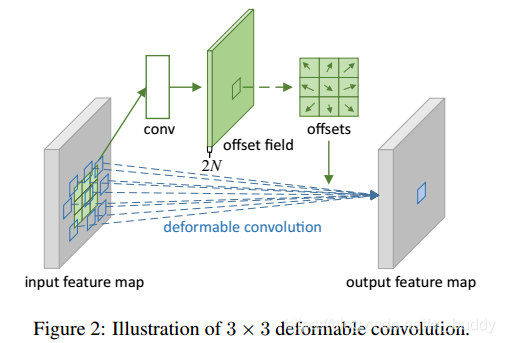1. 前言
传统的卷积网络由于其固有的卷积特性(卷积核中单元位置固定)为其带来了先天的固定几何变换。那么直接的思想就是使卷积的为位置不固定,从而增加CNN网络的表达能力,为这篇文章给出了可变形卷积与可变形ROI Pooling,两者都基于这样的想法:增加模块中的空间采样位置以及额外的偏移量,并且从目标任务中学习偏移量,而不需要额外的监督。新模块可以很容易地替换现有CNN中的普通模块,并且可以通过标准的反向传播便易地进行端对端训练,从而产生可变形卷积网络。
无论是现有的分割、分类还是检测任务网络中,其中图片中几何变换信息大多是来自于数据增广;而且这样并不能很好掌控图像几何变化信息。因而在本文中给出了Deformable Convolution Network,如下图所示:

上图中a是标准的卷积,后面的几种就是通过变形之后的卷积了。在网络中卷积的偏移量通过附加的卷积层从前面的feature map中学习。因此,变形以局部、密集和自适应的方式取决于输入特征。变形卷积正是这样高效、简单地实现端到端复杂空间变换。
2. 可行变卷积
2D卷积包含两步:1)用规则的网格
在输入特征映射
上采样;2)对
加权的采样值求和。网格
定义了感受野的大小和扩张。例如,

定义了一个扩张大小为1的
卷积核。上面的
之类的是代表相对卷积中心的相对坐标。对于输出特征映射
上的每个位置
,我们有

其中
枚举了
中的位置(坐标),这是原始卷积的运算表达式。然而,在可变形卷积中,规则的网格
通过偏移
增大,其中
,也就是卷积核中元素的个数。方程(1)变为
就是相当于在原始卷积操作的基础上增加了偏移,采样是在不规则且有偏移的位置
上。由于偏移
通常是小数,那么偏移之后所在位置处参与卷积计算的值是怎么计算的呢?在论文中说是使用双线性插值算法实现的。

其中
表示任意(小数)位置(公式(2)中
),
枚举了特征映射
中所有整体空间位置,
是双线性插值的核。注意
是二维的。它被分为两个一维核

其中
。方程(3)可以快速计算因为
仅对于一些
是非零的。
下图是Deformable Convolution的说明图。其通过在相同的输入特征映射上应用卷积层来获得偏移。卷积核具有与当前卷积层相同的空间分辨率和扩张。输出偏移域与输入特征映射具有相同的空间分辨率。通道维度2N对应于N个2D偏移量。在训练过程中,同时学习用于生成输出特征的卷积核和偏移量。为了学习偏移量,梯度通过方程(3)和(4)中的双线性运算进行反向传播。

对于Deformable ROI Pooling也是与上面类似的思想进行实现的,其说明图如下:

这里就不展开进行说明了。
3. Caffe中使用Deformable Convolution
目前在Git仓库中已经有DCN网络的实现了,这里只需要在Caffe中添加相应的层就好了。Deformable-ConvNets-caffe
这里需要的文件都在文件夹deformable_conv_cxx/下,这里复制里面的cu文件和cpp文件到caffe/src/caffe/layers下,将h头文件放在caffe/include/caffe/layers目录下。之后修改caffe.proto文件,在里面对应位置处添加如下内容:
optional DeformableConvolutionParameter deformable_convolution_param = 999;
message DeformableConvolutionParameter {
optional uint32 num_output = 1;
optional bool bias_term = 2 [default = true];
repeated uint32 pad = 3; // The padding size; defaults to 0
repeated uint32 kernel_size = 4; // The kernel size
repeated uint32 stride = 6; // The stride; defaults to 1
repeated uint32 dilation = 18; // The dilation; defaults to 1
optional uint32 pad_h = 9 [default = 0]; // The padding height (2D only)
optional uint32 pad_w = 10 [default = 0]; // The padding width (2D only)
optional uint32 kernel_h = 11; // The kernel height (2D only)
optional uint32 kernel_w = 12; // The kernel width (2D only)
optional uint32 stride_h = 13; // The stride height (2D only)
optional uint32 stride_w = 14; // The stride width (2D only)
optional uint32 group = 5 [default = 4];
optional uint32 deformable_group = 25 [default = 4];
optional FillerParameter weight_filler = 7; // The filler for the weight
optional FillerParameter bias_filler = 8; // The filler for the bias
enum Engine {
DEFAULT = 0;
CAFFE = 1;
CUDNN = 2;
}
optional Engine engine = 15 [default = DEFAULT];
optional int32 axis = 16 [default = 1];
optional bool force_nd_im2col = 17 [default = false];
}
Deformable Convolution的输入参数维度要求为:
bottom[0](data): (batch_size, channel, height, width)
bottom[1] (offset): (batch_size, deformable_group * kernel[0] * kernel[1]*2, height, width)
网络的输出为:
out_height=f(height, kernel[0], pad[0], stride[0], dilate[0])
out_width=f(width, kernel[1], pad[1], stride[1], dilate[1])
其中运算 被定义为:
f(x,k,p,s,d) = floor((x+2*p-d*(k-1)-1)/s)+1
使用如下卷积作为offset layer:
layer {
name: "offset"
type: "Convolution"
bottom: "pool1"
top: "offset"
param {
lr_mult: 1
}
param {
lr_mult: 2
}
convolution_param {
num_output: 72
kernel_size: 3
stride: 1
dilation: 2
pad: 2
weight_filler {
type: "xavier"
}
bias_filler {
type: "constant"
}
}
}
Deformable Convolution Layer:
layer {
name: "dec"
type: "DeformableConvolution"
bottom: "conv1"
bottom: "offset"
top: "dec"
param {
lr_mult: 1
}
param {
lr_mult: 2
}
deformable_convolution_param {
num_output: 512
kernel_size: 3
stride: 1
pad: 2
engine: 1
dilation: 2
deformable_group: 4
weight_filler {
type: "xavier"
}
bias_filler {
type: "constant"
}
}
}
使用时候的网络结构应该为:

错误修正
在添加Deformable Convolution Layer的时候可能会存在如下的错误:
Check failed: registry.count(type) == 1 (0 vs. 1) Unknown layer type: DeformableConvolution
也就是找不到这个层,原因是cpp文件中没有对其进行注册,因而需要修改对应位置处代码为:
#ifdef CPU_ONLY
STUB_GPU(DeformableConvolutionLayer);
#endif
INSTANTIATE_CLASS(DeformableConvolutionLayer);
REGISTER_LAYER_CLASS(DeformableConvolution); // add register